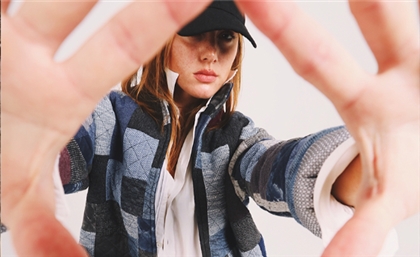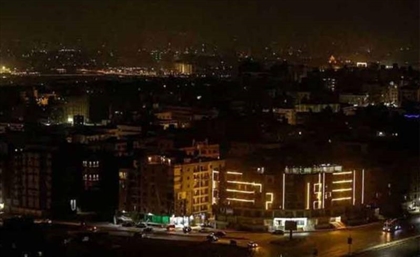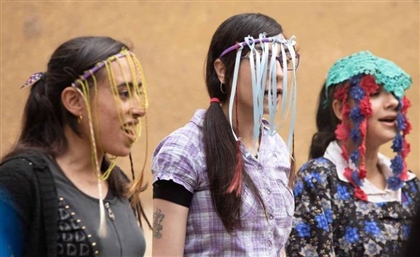Slickr: Cycle of Style
You've all seen that ubiquitous yellow arrow flood your social media streams, promising a e-commerce revolution of sorts, and now it's time to let the cat out of the designer bag. Farah Hosny meets the founders of Slickr and gets the exclusive...

Unless you’ve been hiding out under a rock somewhere, odds are you’ve probably seen that ubiquitous circular, electric yellow arrow that’s positively invaded social media across the city in recent weeks, otherwise known as the calling card for a revolutionary new fashion platform that’s about to engulf the sartorial side of life here in Egypt; Slickr. The simple sign and the brand it represents, has managed to permeate the consciousness of Cairo with their guerrilla marketing campaign, making it the name on everyone’s lips, without actually disclosing any real revelatory details. One might call it a tease.
“This is actually exactly what we wanted to achieve,” Maria Muñoz, one of the brand’s founders tells us as we stroll into Slickr’s Zamalek headquarters. “We wanted people to know about us and to create this sort of mystery and buzz around Slickr, before the actual launch.” The office the team works out of, which doubles as the home of the brand’s other founder Mohamed Tarek, is casually cool; plush couches everywhere; one wall take up by a giant white backdrop where they’ve shot anyone who’s anyone (fashionable peeps they’ve fondly called their ambassadors), with their now-iconic Slickr sign; another wall overloaded with Post-Its scribbled over with all their ideas.

Granted, it reeks of a creative hub, but for what exactly? “Look, it’s a concept called social shopping,” Tarek explains of the upcoming site as we take a seat next to a table just casually topped with a tarboush. “It hasn’t been introduced to Egypt but it’s been around. The concept is very easy – it’s an integration of a social network, with an e-commerce platform; it makes the experience completely different.” Essentially, Slickr is an amalgam of online shopping and good ol’ social networking; part profile-driven, part retail therapy, an all-encompassing fashionaholic’s digital dream.
The two, one a PR maven, one a jack-of-all trades entrepreneur, neither of whom have a serious background in fashion, thought up the idea around a year ago; an idea designed to dominate the digital fashion sphere with its unique approach and one which has yet to be seen elsewhere. Spanish-born Muñoz, who felt a draw to Egypt, wanted to branch into something new and Tarek got her on board with Slickr. The idea emanated as a passion project for both of them and evolved from there.

“As a user, you have your profile where and your community of friends; you can create your closet, your wishlist, add friends, follow people, track brands, check your favourite items of each brand, you can follow blogs…” Muñoz elaborates. The site functions partially like Facebook, in that you have a home feed and all, but it goes several thousand steps further. Outfits posted on personal profiles are tagged and linked so you can click on your favourite fashionista's look and be taken straight to the page where you can by the item. “You can reach what they’re wearing with a click,” Tarek says simply, taking a casual puff of his painfully hipster pipe. “And it’s actually smart,” he continues; the technology their wizarding programmers have created allows the site to recognise trends in your behaviour, similarly to Instagram, and alters and adjusts what you see accordingly. If Pinterest and Net-a-Porter had a baby and it contained blogger DNA, had a crazy old aunt called Tumblr and Polyvore was its godmother, it might come close to describing the site. Everything is interrelated; a seamless fusion of different elements that’ll likely induce hardcore Instagram-style stalking. And we were treated to a sneak peek of the site – because we’re cool like that – still in its testing phases, and its design is equal parts sleek à la Peony Lim, and edgy enough to catch the eye of those eclectic fashionistas. “The final aim is to disrupt the fashion industry,” Muñoz says simply. “To bring in a new concept.”

What they’re seeking to do is allow everyone to express their style, on one comprehensive platform. The two masterminds behind Slickr clearly each have their own aesthetic when it comes to fashion too - Muñoz decked out in slim fitting long-sleeved, long black dress, à la the uber-fashionable Morticia Adams, while Tarek’s gone the grunge route, ripped jeans and a vest over a plain white tee – both vastly different but highly reflective of what their site is all about; each user’s separate individuality when it comes to style. “Fashion is part of the way you express yourself,” Muñoz explains, and the site will allow users to do just that.
In the midst of inciting riot-worthy buzz about itself, the brand’s been carefully curating an impressive roster of stylish citizens in the form of brand ambassadors. Aside from procuring some of the country’s most prominent design names including Amina K and her cultural couture, and Js’ Designs’ edgy jewellery, to feature on the site, Slickr’s teaser campaign has seen them gather a select group of “people that are somehow involved in the fashion world in Egypt, who are quite active on social media and who have a sense for fashion, whether they are actresses, models, designers, fashionistas...” Muñoz explains.
As per our Instagram stalking, as well as the invasion of our own office with their funky yellow sign, ambassadors, that include everyone from models like Zeinab Azzam, bloggers like Radwa El Ziki, stylists like Farah El Sayed, and all around fashionable fiends like Amira Azzouz from Fustany, have clearly been having a blast posing with the neon yellow Slickr sign. And the significance of the sign itself, which looks a little like a refresh button on acid, is that concept of connectivity that the brand is based on. “It’s the network, it’s that connection. What we’re doing is connecting the fashion industry, and then giving them reach to the people. What we’re doing now with our ambassadors is collecting people involved in fashion, collecting the brands, connecting them with the bloggers, with the photographers, with designers…” Tarek explains. The sign symbolises essentially, a cycle of style. And then they’ve taken it up a notch; from the large network of ambassadors they’ve amassed, “designers will be able to pick out their ambassadors… If for instance, Amina K likes you or she thinks you suit her brand’s personality, she will pick you, and lend you or give you stuff so you can wear it and tag her,” Muñoz finishes with a flourish.
Through integrating the entire fashion community, they’ve got their sights set on total domination; “We want occupy Instagram, Facebook, whatever, with the Slickr sign,” Muñoz says. But as for the bigger story? “The true meaning of the sign, the true meaning of the name, will be revealed in a year,” Tarek says mysteriously...
What they can say, however, is that Egypt is just the beginning. The site, which is expected to launch in December (“as soon as our super ninja engineers sort out all the bugs and kinks!”), not only has its eyes set beyond Egypt, with plans of international expansion at some point, but also promises a few more tricks up their sleeve. “There’s a much bigger plan,” Muñoz says coyly. “This is the first step.” It’s more like a lunge, really.
Though they’ve collected a kickass variety of designers, everyone from The Sahara Collection to Okhtein, Vintique to Krak Baby, the site takes zero commission on featuring these fashion houses. Their premium brands get some killer customisations; a specially created technological wonderland you’ll soon be able to see for yourself that integrates something called ‘parallax technology’ which in normal people non-programmer speak, just means seriously cool graphics, visuals, and interactive elements.

But essentially, Slickr’s motive is to curate a community. Picture a mutually beneficial scenario; where users have access to fashion and the industry in turn has access to their users’ opinions, at once empowering the consumer while allowing the brands to get their hands on information that’ll help them satisfy their customers. The photos that’ll circle the site won’t just be of the hyper-stylised kind; it’ll be more reflective of real life, as users post their own pictures. “We believe this is the evolution of fashion. This is going to be true marketing,” Tarek says. “You’ll be seeing real people, not dolls. Not that Photoshop attack. That is being attacked right now and we’re aiming to give the power to the people.” Talk about revolutionary.
The site is set to launch soon, and we’re certainly awaiting with breath that is baited. They’ll also be celebrating with a big shebang come January so mark your calendars. “The idea is, the fashion industry really needs some change,” Tarek states simply. “And our final aim is to disrupt that industry.” Disrupt away guys, we can’t wait for this social sartorial experiment to begin.
- Previous Article Give Thanks... to Zitouni
- Next Article Ridley Scott: 'Mohammad So-and-So' Won't Make Me Money
























